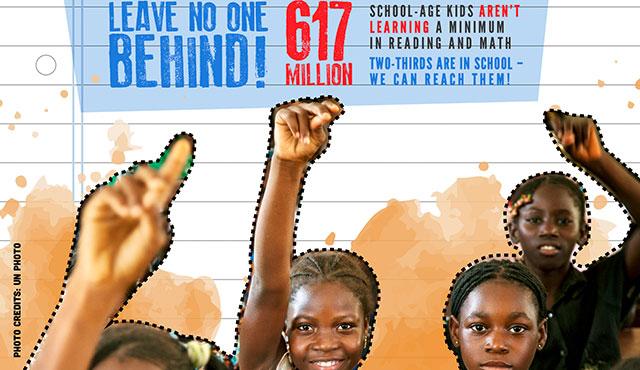6 Out of 10 Children and Adolescents Are Not Learning a Minimum in Reading and Math
Share
21/09/2017

New data from the UNESCO Institute for Statistics show that 617 million children and adolescents worldwide are not achieving minimum proficiency levels in reading and mathematics. The figure signals “a learning crisis” according to the UIS, which could threaten progress towards the Sustainable Development Goals (SDGs).
“This is the equivalent of three times the population of Brazil being unable to read or handle basic mathematics with proficiency,” says Silvia Montoya, Director of the UIS. “The waste of human potential signalled by the new data confirms that getting children into the classroom is only half the battle. Now we must ensure that every child in that classroom is learning the basic skills they need in reading and mathematics, as a minimum.”
Globally, six out of ten children and adolescents are not learning a minimum in reading and mathematics, according to a new UIS paper. The total – 617 million – includes more than 387 million children of primary school age and 230 million adolescents of lower secondary school age. This means that more than one-half – 56% – of all children won’t achieve minimum proficiency levels by the time they should be completing primary education. The proportion is even higher for adolescents at 61%.
Sub-Saharan Africa has the single largest number – 202 million – of children and adolescents who are not learning. Across the region, nearly nine out of ten kids between the ages of about 6 and 14 are not gaining minimum proficiency levels in reading and mathematics. Central and Southern Asia has the second-highest rate, with 81% or 241 million not learning.
The data suggest that the new numbers are rooted in three common problems. First, the lack of access, with children who are out of school having little or no chance to reach a minimum level of proficiency. Second, a failure to retain every child in school and keep them on track. And third, the issue of education quality and what is happening within the classroom itself.
Most children who are not learning are in school
Two-thirds of the children who are not learning are in school. Of the 387 million primary school-age children unable to read proficiently, 262 million are in school. There are also about 137 million adolescents of lower secondary school age who are in classrooms but unable to meet minimum proficiency levels in reading.
“The figures are staggering but they show the way forward,” says Ms Montoya. “We know where these children live and go to school. They are not hidden or isolated from their governments and communities – they are sitting in classrooms with their own aspirations and potential. We can reach these kids but not by simply hoping that they stay in school and grasp the basics.”
About the new data
The new data are the very first to be gathered on progress towards SDG Target 4.1., which requires primary and secondary education that lead to ‘relevant and effective learning outcomes’. The new indicator includes children and adolescents of primary and lower secondary school age who are in school and out.
To develop the estimates, the UIS created a new learning outcomes database that anchors the assessment results of more than 160 countries/territories between 1995 and 2015. The database uses two different benchmarks in order reflect the contexts of countries with different income levels. It uses the SACMEQ benchmark (referred to as the basic proficiency level) for reading and mathematics at the primary level. In addition, the database includes results (presented in the new paper) using the minimum proficiency level defined by the IEA for PIRLS and TIMSS, which are international assessments involving middle- and high-income countries. For the secondary level, the benchmark used by PISA were applied.
*The new fact sheet is also available in French and Spanish.